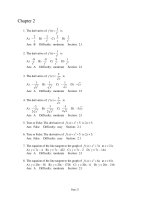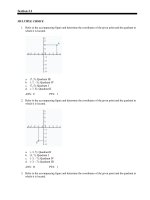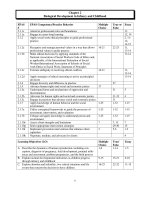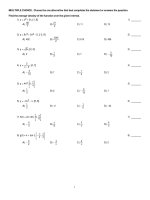Brooks cole empowerment series understanding human behavior and the social environment 9th edition zastrow test bank
Bạn đang xem bản rút gọn của tài liệu. Xem và tải ngay bản đầy đủ của tài liệu tại đây (156.13 KB, 10 trang )
Chapter 2
Biological Development in Infancy and Childhood
EPAS
#
2.1.1c
2.1.1e
2.1.2
EPAS Competency/Practice Behavior
2.1.2a
Recognize and manage personal values in a way that allows
professional values to guide practice
Make ethical decisions by applying standards of the
National Association of Social Workers Code of Ethics and,
as applicable, of the International Federation of Social
Workers/International Association of Schools of Social
work Ethics in Social Work, Statement of Principles
Tolerate ambiguity in resolving ethical conflicts
2.1.2b
2.1.2c
2.1.2d
2.1.4
2.1.5
2.1.5a
2.1.5b
2.1.5c
2.1.7
2.1.7a
2.1.7b
2.1.10e
2.1.10g
2.1.10i
2.1.10k
Multiple
Choice
True or
False
Attend to professional roles and boundaries
Engage in career-long learning
Apply social work ethical principles to guide professional
practice
Apply strategies of ethical reasoning to arrive at principled
decisions
Engage diversity and difference in practice
Advance human rights and social and economic justice
Understand forms and mechanisms of oppression and
discrimination
Advocate for human rights and social and economic justice
Engage in practices that advance social and economic justice
Apply knowledge of human behavior and the social
environment
Utilize conceptual frameworks to guide the processes of
assessment, intervention, and evaluation
Critique and apply knowledge to understand person and
environment
Assess client strengths and limitations
Select appropriate intervention strategies
Implement prevention interventions that enhance client
capacities
Negotiate, mediate, and advocate for clients
Learning Objectives (LO)
A. Describe the dynamics of human reproduction, including conception, diagnosis of pregnancy, fetal development, prenatal influences and assessment, problem pregnancies, and the birth process
B. Explain normal developmental milestones as children progress
through infancy and childhood
C. Explore abortion and infertility, two critical situations and life
events that concern the decision to have children
11
16-21
22-23
16-21
Essay
13
12, 14
2, 1112,
14-15
11,
13-14
13-14
11,
13-14
13-14
27
17
31
5
4
1-25
31-32
31
1-32
1-25
1-32
1-15
1-25
1-32
1-15
7
7, 13
29-30
5-6
7
15
1-2
3
1-15
4
Multiple
Choice
1-8
True/
False
1-14
Essay
9-15
15-21
6-10
16-25
22-32
11-15
1-5
Multiple-Choice Questions
1.
Fingerlike projections called _____ at the end of the fallopian tube draw the egg into the tube.
A.
Cilia
B.
Blastocyst
C.
Fimbriae
D.
Zygote
ANS: C
2.
LO: A
PG: 57
EPAS: 2.1.7, 2.1.7a, 2.1.7b
LO: A
PG: 61
EPAS: 2.1.7, 2.1.7a, 2.1.7b, 2.1.10i
Symptoms of _____ include high blood pressure, rapid weight gain, fluid retention, protein in the
urine, and can cause death.
A.
Toxemia
B.
Alpha-feto
C.
Ectopia
D.
Oxytocin
ANS: A
5.
EPAS: 2.1.7, 2.1.7a, 2.1.7b
Which of the following is true:
A.
Pregnant women over age forty have about a 1 in 1,000 chance of giving birth to a baby
with Down syndrome
B.
Women age 35 and over account for over 30 percent of all births in the United States
C.
Teen mothers account for over 10 percent of all U.S. births
D.
Infants born to women over 35 are more likely to be underweight
ANS: C
4.
PG: 57
The genetic material in the egg and sperm combine to form a single cell called a:
A.
Blastocyst
B.
Zygote
C.
Cilia
D.
Fimbriae
ANS: B
3.
LO: A
LO: A
PG: 64
EPAS: 2.1.7, 2.1.7a, 2.1.7b
The longest stage of labor is the:
A.
First stage
B.
Second stage
C.
Third stage
D.
None of the above; all stages resemble each other in length
ANS: A
LO: A
PG: 65
EPAS: 2.1.7, 2.1.7a, 2.1.7b
12
6.
Approximately 95 percent of babies are born with their heads emerging first. This is referred to
as a _______ presentation.
A.
Transverse
B.
Vertex
C.
Breech
D.
Caesarean
ANS: B
7.
PG: 67
EPAS: 2.1.7, 2.1.7a, 2.1.7b, 2.1.10e
LO: A
PG: 68
EPAS: 2.1.7, 2.1.7a, 2.1.7b
LO: B
PG: 70
EPAS: 2.1.7, 2.1.7a, 2.1.7b
A child is usually able to crawl well by age:
A.
4 months
B.
6 months
C.
8 months
D.
1 year
ANS: D
11.
LO: A
_____ development refers to the tendency to develop aspects of the body trunk first and then later
master manipulation of the body extremities.
A.
Pleiotrodal
B.
Cephalocaudal
C.
Cryptorchistal
D.
Proximodistal
ANS: D
10.
EPAS: 2.1.7, 2.1.7a, 2.1.7b
Approximately ______ percent of babies born in the United States have low birth weights.
A.
2
B.
8
C.
15
D.
22
ANS: B
9.
PG: 66
The maximum Apgar score possible is:
A.
10
B.
20
C.
36
D.
50
ANS: A
8.
LO: A
LO: B
PG: 73
EPAS: 2.1.7, 2.1.7a, 2.1.7b
At _____, children’s vocabularies consist of more than three but less than fifty words.
A.
1 year
B.
18 months
C.
2 years
D.
3 years
ANS: B
LO: B
PG: 74
EPAS: 2.1.7, 2.1.7a, 2.1.7b
13
12.
By age _____, children can use the toilet by themselves, although they frequently ask someone to
go with them, with accidents only occasionally happening at night.
A.
18 months
B.
2 years
C.
2 1/2 years
D.
3 years
ANS: D
13.
LO: B
PG: 75
EPAS: 2.1.7, 2.1.7a, 2.1.7b
LO: B
PG: 75-76
EPAS: 2.1.7, 2.1.7a, 2.1.7b
_____-year-olds can begin to be trusted with an allowance, they are able to go to school or to
friends’ homes alone, go to bed alone, and get up by themselves during the night to go to the
bathroom.
A.
4 to 5
B.
6 to 8
C.
9 to 10
D.
11 to 12
ANS: B
16.
EPAS: 2.1.7, 2.1.7a, 2.1.7b
At _____ years old, the pictures children draw, although simple, are finally recognizable.
Dominance of the left or right hand becomes well established.
A.
4
B.
5
C.
6
D.
7
ANS: B
15.
PG: 75
_____ -year-olds are in the process of separating from their parents and begin to prefer the
company of other children over adults.
A.
2½
B.
3
C.
4
D.
5
ANS: C
14.
LO: B
LO: B
PG: 77
EPAS: 2.1.7, 2.1.7a, 2.1.7b
In ______ the Supreme Court confirmed that Congress and individual states could legally refuse
to pay for abortions.
A.
Roe v. Wade
B.
Webster v. Wainright
C.
Harris v. McRae
D.
McHenry v. Smith
ANS: C
LO: C
PG: 81
EPAS: 2.1.2a, 2.1.2c, 2.1.7, 2.1.7a, 2.1.7b
14
17.
Which one of the following countries prohibits abortions:
A.
Portugal
B.
Nicaragua
C.
France
D.
Poland
ANS: D
18.
PG: 84-85
EPAS: 2.1.2a, 2.1.2c, 2.1.7, 2.1.7a, 2.1.7b
LO: C
PG: 86
EPAS: 2.1.2a, 2.1.2c, 2.1.7, 2.1.7a, 2.1.7b
LO: C
PG: 86
EPAS: 2.1.2a, 2.1.2c, 2.1.7, 2.1.7a, 2.1.7b
The following is true about vacuum aspiration:
A.
This is considered a second trimester abortion
B.
The procedure is used up to 16 weeks after a missed period
C.
The entire procedure takes approximately one hour
D.
Most are performed in a hospital under general anesthesia
ANS: B
22.
LO: C
Which of the following is true:
A.
Non-Hispanic women are 60 percent more likely to have abortions than Hispanic women
B.
Twenty-five percent of women who have abortions had used a contraception method
during the month they became pregnant
C.
Approximately 33 percent of all abortions are performed on teenage girls
D.
Sixty-five percent of women having an abortion reported having a religious affiliation
ANS: D
21.
EPAS: 2.1.2a, 2.1.2c, 2.1.5, 2.1.7, 2.1.7a, 2.1.7b
Approximately ______ percent of abortions are performed at or before 12 weeks gestation.
A.
58
B.
68
C.
78
D.
88
ANS: D
20.
PG: 82
Which of the following is true regarding embryonic stem cell research:
A.
Individual states have the authority to pass laws to permit research using state funds
B.
The first fetal cell transplant for Parkinson’s disease was performed for the first
time in 2002
C.
They are taken from an 8-day-old embryo
ANS: A
19.
LO: C
LO: C
PG: 87
EPAS: 2.1.2a, 2.1.2c, 2.1.7, 2.1.7a, 2.1.7b
_____ was formerly referred to as RU-486, it triggers a deterioration of the uterine lining, and
was approved by the U.S. Federal Drug Administration for use as an abortion drug in 2000.
A.
Mifepristone
B.
Laminaria
C.
Methotrexate
D.
Misoprostol
ANS: A
LO: C
PG: 88
EPAS: 2.1.7, 2.1.7a, 2.1.7b
15
23.
Approximately ______ percent of couples in the United States are infertile.
A.
3
B.
5
C.
11
D.
22
ANS: C
24.
PG: 93
EPAS: 2.1.7, 2.1.7a, 2.1.7b
All of the following are true regarding pelvic inflammatory disease except:
A.
It can be caused by tumors
B.
Often results from sexually transmitted infections
C.
It is an infection of the female reproductive tract
D.
It is the result of endometriosis
ANS: D
25.
LO: C
LO: C
PG: 94
EPAS: 2.1.7, 2.1.7a, 2.1.7b
The most common cause of infertility in men is:
A.
A low sperm count
B.
Reactions to such drugs as alcohol, narcotics, or marijuana
C.
Varicose veins in the scrotum and testes
D.
The decreased ability of sperm to swim
ANS: A
LO: C
PG: 94
EPAS: 2.1.7, 2.1.7a, 2.1.7b
True or False Questions
1.
The typical ejaculate contains a maximum of 90 million sperm.
ANS: F
2.
PG: 57
EPAS: 2.1.7, 2.1.7a, 2.1.7b
LO: A
PG: 58
EPAS: 2.1.7, 2.1.7a, 2.1.7b
LO: A
PG: 59
EPAS: 2.1.7, 2.1.7a, 2.1.7b
Symptoms of folic acid deficiency are anemia and fatigue.
ANS: T
6.
LO: A
Viability is an especially important concept during the first trimester of pregnancy.
ANS: F
5.
EPAS: 2.1.7, 2.1.7a, 2.1.7b
Lab pregnancy tests can detect HCG in urine as early as 8 days after conception.
ANS: T
4.
PG: 57
It is possible for sperm to remain viable for up to 72 hours.
ANS: T
3.
LO: A
LO: A
PG: 59
EPAS: 2.1.7, 2.1.7a, 2.1.7b, 2.1.10i
Over-the-counter drugs, such as aspirin, have been found to be harmful to some pregnant mothers
and their babies.
ANS: T
LO: A
PG: 60
EPAS: 2.1.7, 2.1.7a, 2.1.7b, 2.1.10i
16
7.
Spina bifida is a condition in which the spinal column has not fused shut.
ANS: T
8.
PG: 64
EPAS: 2.1.7, 2.1.7a, 2.1.7b
LO: A
PG: 65
EPAS: 2.1.7, 2.1.7a, 2.1.7b
LO: A
PG: 66
EPAS: 2.1.7, 2.1.7a, 2.1.7b
LO: A
PG: 67
EPAS: 2.1.7, 2.1.7a, 2.1.7b, 2.1.10e
LO: A
PG: 70
EPAS: 2.1.7, 2.1.7a, 2.1.7b
LO: B
PG: 71
EPAS: 2.1.7, 2.1.7a, 2.1.7b
LO: B
PG: 71
EPAS: 2.1.7, 2.1.7a, 2.1.7b
Four-month-old babies are able to sit alone without being supported.
ANS: F
18.
LO: A
Very few theorists believe that the environment is a crucial influence on development.
ANS: F
17.
EPAS: 2.1.7, 2.1.7a, 2.1.7b
One of the major concepts involved in understanding the process of human development is the
importance of individual differences.
ANS: T
16.
PG: 62
The Babinski reflex involves the stretching, fanning movement of the toes whenever the infant is
stroked on the bottom of his or her feet.
ANS: T
15.
LO: A
The Brazelton Neonatal Behavioral Assessment Scale is administered immediately after birth.
ANS: F
14.
EPAS: 2.1.7, 2.1.7a, 2.1.7b
Babies born with their heads emerging first is referred to as a breech presentation.
ANS: F
13.
PG: 62
Babies are actually born during the third stage of labor.
ANS: F
12.
LO: A
Approximately 20 percent of all pregnancies result in spontaneous abortion.
ANS: T
11.
EPAS: 2.1.7, 2.1.7a, 2.1.7b, 2.1.10e
Chorionic villi sampling is a method for diagnosing defects in the developing fetus.
ANS: T
10.
PG: 62
Umbilical cord assessment involves using high frequency sound waves to produce an actual
picture of the fetus within the womb.
ANS: F
9.
LO: A
LO: B
PG: 72
EPAS: 2.1.7, 2.1.7a, 2.1.7b
By age 18 months, a baby can walk and descend stairs by crawling down backwards.
ANS: T
LO: B
PG: 73
EPAS: 2.1.7, 2.1.7a, 2.1.7b
17
19.
At age 2, children tend to play alongside of each other, but not with each other in a cooperative
fashion.
ANS: T
20.
LO: C
PG: 80
EPAS: 2.1.2a, 2.1.7, 2.1.7a, 2.1.7b
LO: C
PG: 84
EPAS: 2.1.2a, 2.1.2c, 2.1.7, 2.1.7a, 2.1.7b
LO: C
PG: 88
EPAS: 2.1.7, 2.1.7a, 2.1.7b
LO: C
PG: 88
EPAS: 2.1.7, 2.1.7a, 2.1.7b
LO: C
PG: 88
EPAS: 2.1.7, 2.1.7a, 2.1.7b
LO: C
PG: 89
EPAS: 2.1.4, 2.1.7, 2.1.7a, 2.1.7b
The primary cause of infertility in women involves difficulties with ovulation.
ANS: T
29.
EPAS: 2.1.7, 2.1.7a, 2.1.7b
Research has shown that serious psychological distress is far more prevalent after having an
abortion than the occurrence of postpartum depression in women who carry their pregnancies to
term.
ANS: F
28.
PG: 77
Dilation and evacuation is an abortion method which must be performed in the first trimester of
pregnancy.
ANS: F
27.
LO: B
Second-trimester abortions are more complicated and involve greater risks than first-trimester
abortions.
ANS: T
26.
EPAS: 2.1.7, 2.1.7a, 2.1.7b
RU 486 was approved by the Federal Drug Administration in 2008.
ANS: F
25.
PG: 75
Congress has passed a law that makes blocking access to women’s clinics a crime punishable by
prison terms and/or fines.
ANS: T
24.
LO: B
The National Association of Social Workers’ (NASW) position concerning abortion services is
based on the principle of self-determination.
ANS: T
23.
EPAS: 2.1.7, 2.1.7a, 2.1.7b
Ages 6 to 8 is the period that frequently becomes the finale of the games and play of childhood.
ANS: F
22.
PG: 74
Three-year-olds tend to pay close attention to the adults around them and are eager to please.
ANS: T
21.
LO: B
LO: C
PG: 93
EPAS: 2.1.7, 2.1.7a, 2.1.7b
Direct sperm injections are seldom used when men have exceptionally low sperm counts or large
numbers of abnormal sperm.
ANS: F
LO: C
PG: 97
EPAS: 2.1.7, 2.1.7a, 2.1.7b, 2.1.10g
18
30.
A woman may function as a surrogate without using her own genetic material.
ANS: T
31.
PG: 98
EPAS: 2.1.7, 2.1.7a, 2.1.7b, 2.1.10g
Fertilization enhancement techniques are now relatively inexpensive processes.
ANS: F
32.
LO: C
LO: C
PG: 99
EPAS: 2.1.5a, 2.1.5b, 2.1.5c, 2.1.7, 2.1.7a,
2.1.7b
The first level involved in the feminist treatment of infertility addresses the general social
attitudes about infertility and expectations about what infertile women should do.
ANS: F
LO: C
PG: 100
EPAS: 2.1.5b, 2.1.7, 2.1.7a, 2.1.7b
Discussion Topics or Essay Questions
1.
Discuss the prenatal factors that can influence the health and development of the fetus.
ANS: N/A
2.
LO: A
PG: 62
EPAS: 2.1.7, 2.1.7a, 2.1.7b
LO: A
PG: 63
EPAS: 2.1.5b, 2.1.7, 2.1.7a, 2.1.7b, 2.1.10k
LO: A
PG: 69
EPAS: 2.1.5a, 2.1.7, 2.1.7a, 2.1.7b
LO: B
PG: 71
EPAS: 2.1.7, 2.1.7a, 2.1.7b
Why is knowledge of human development and developmental milestones relevant to social work?
ANS: N/A
8.
EPAS: 2.1.2, 2.1.7, 2.1.7a, 2.1.7b, 2.1.10i
Explain the Nature-Nurture controversy in human development.
ANS: N/A
7.
PG: 60
How does the United States compare to other nations in regard to low-birth-weight infants? What
are the reasons?
ANS: N/A
6.
LO: A
Describe how social work practitioners can help low income women overcome the obstacles in
the macro environment for greater access to prenatal care.
ANS: N/A
5.
EPAS: 2.1.7, 2.1.7a, 2.1.7b, 2.1.10i
List the advantages and disadvantages of each of the following prenatal tests: (a) ultrasound, (b)
amniocentesis, (c) chorionic villi sampling.
ANS: N/A
4.
PG: 59
Should a pregnant woman who consumes illegal drugs that damage her child be punished as a
criminal? Should her child be taken from her? If so, with whom should the child be placed?
ANS: N/A
3.
LO: A
LO: B
PG: 71
EPAS: 2.1.7, 2.1.7a, 2.1.7b, 2.1.10e
Describe the major normal developmental milestones attained by a 4-month old child.
ANS: N/A
LO: B
PG: 72
EPAS: 2.1.7, 2.1.7a, 2.1.7b
19
9.
Cite the major normal developmental milestones attained by a 1-year-old child.
ANS: N/A
10.
PG: 75-76
EPAS: 2.1.7, 2.1.7a, 2.1.7b
LO: C
PG: 77-84
EPAS: 2.1.2, 2.1.2a, 2.1.2c, 2.1.7, 2.1.7a, 2.1.7b
LO: C
PG: 84-85
EPAS: 2.1.1e, 2.1.2, 2.1.7, 2.1.7a, 2.1.7b
Identify and describe the roles social workers can assume when helping women with unwanted
pregnancies.
ANS: N/A
14.
LO: B
Describe the positive developments and the concerns regarding stem cell research. What is your
opinion about using embryonic stem cells for research?
ANS: N/A
13.
EPAS: 2.1.7, 2.1.7a, 2.1.7b
Summarize and discuss the arguments for pro-choice and for anti-abortion. Where do you stand
on this issue?
ANS: N/A
12.
PG: 73
Explain the major normal developmental milestones attained by a 5-year-old child.
ANS: N/A
11.
LO: B
LO: C
PG: 90
EPAS: 2.1.1c, 2.1.2a, 2.1.2b, 2.1.2c, 2.1.2d,
2.1.7, 2.1.7a, 2.1.7b
Consider the following situation:
A 32-year-old woman with a severe cognitive disability becomes pregnant. She is unable to take
care of herself independently. However, she has been easy prey to men as she seeks attention and
has a history of numerous sexual encounters. Her genetic background indicates that she would
probably have a child with a cognitive disability. It is clear that she would be unable to care for
any child herself.
How would you apply the hierarchy of ethical principles described in the text to determine what
might be done in this situation?
ANS: N/A
15.
LO: C
PG: 90-92
EPAS: 2.1.1e, 2.1.2, 2.1.2a, 2.1.2b, 2.1.2c,
2.1.2d, 2.1.7, 2.1.7a, 2.1.7b
Discuss and assess the pros and cons of the options available to infertile couples today.
ANS: N/A
LO: C
PG: 95-98
EPAS: 2.1.2, 2.1.7, 2.1.7a, 2.1.7b, 2.1.10g
20









